How Much Does Playground Surfacing Cost?
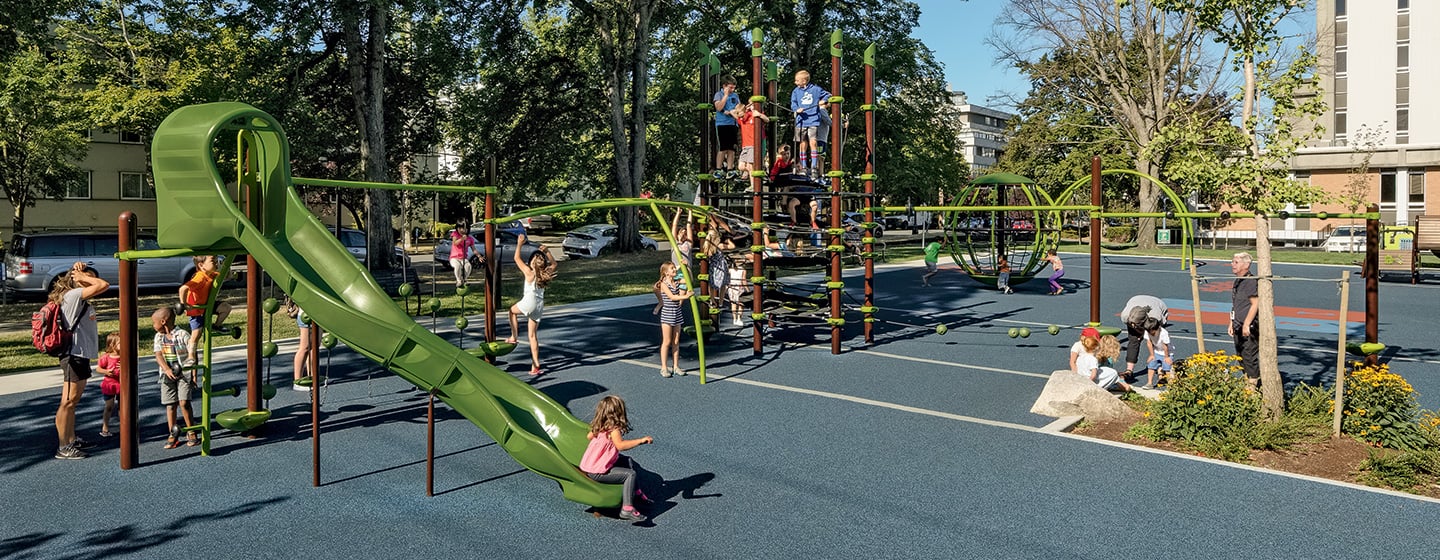
Playground surfacing costs depend on types of surfacing materials, ongoing maintenance of playground surfacing and size of the playground. Investing in the right playground surface will go a long way toward creating a safe play space kids and entire communities can enjoy for years to come.
Costs of Playground Surfacing
Safety is certainly a top priority along with accessibility, but cost is oftentimes the driving force when choosing a playground surface. To determine which playground surface meets your budgetary needs, you must look at the total cost of ownership, which includes not only the initial investment but also the maintenance and expense of upkeep over the life span of the surface.
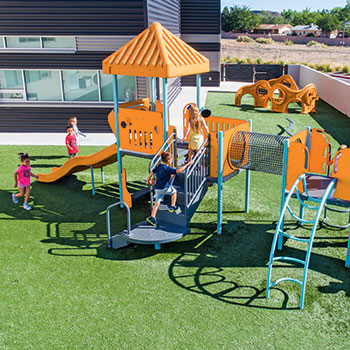
Rubber, Tiles & Synthetic Turf Surfaces
Unitary surfaces like poured-in-place rubber, bond-in-place rubber, interlocking resilient tiles, and synthetic turf are typically a larger upfront investment, but the cost will vary depending on fall height requirements, color choices, the condition of the existing surface and location. For smaller playgrounds the cost per square foot can be more due to the minimum amount of raw material required and can be cost-prohibitive as compared to using loose fill surfaces.
Wood, Sand and Gravel Surfaces
Loose-fill surfaces such as engineered wood fiber, sand or pea gravel are often a more economical initial investment. Materials, size of the area, whether it requires professional installation or site preparation are all factors that influence the initial cost of playground surfacing. There are also delivery and ongoing maintenance costs that must be factored into the decision as well.
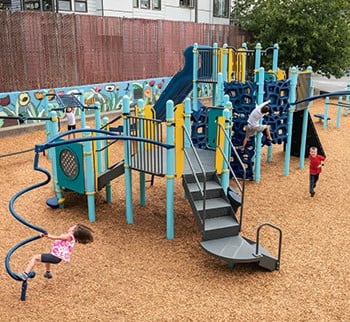 For example, loose-fill material may seem like the most affordable playground surface because it carries the least expensive upfront costs, but sand and wood fiber come with hidden costs that may become burdensome over time. Sand and wood fiber must be inspected bi-weekly to rid the area of any foreign objects, rake the area level and possibly add material to maintain the appropriate depth for fall protection. Over the years, these costs can add up. However, for some large school districts or municipalities that have many playgrounds, it may be easier to top-off and maintain the playground surface versus obtaining the initial necessary budget required for unitary surfaces.
For example, loose-fill material may seem like the most affordable playground surface because it carries the least expensive upfront costs, but sand and wood fiber come with hidden costs that may become burdensome over time. Sand and wood fiber must be inspected bi-weekly to rid the area of any foreign objects, rake the area level and possibly add material to maintain the appropriate depth for fall protection. Over the years, these costs can add up. However, for some large school districts or municipalities that have many playgrounds, it may be easier to top-off and maintain the playground surface versus obtaining the initial necessary budget required for unitary surfaces.
It's important to note that it is difficult for mobility devices to traverse loose-fill surfacing, so additional paths of unitary surfacing may be necessary to allow playground visitors with mobility devices to access the play equipment. This will increase the overall cost of your surfacing investment.
Cost of Maintenance
The amount of necessary maintenance varies from surface to surface and no surface is completely maintenance free. Check with your surface manufacturer or reseller for the recommended maintenance program for the surface you choose.
Loose-Fill Surfacing
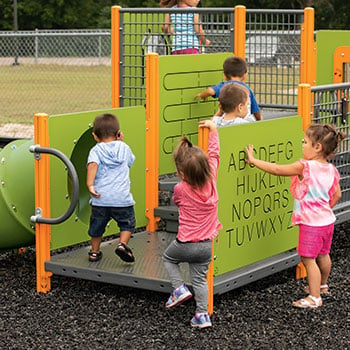 Generally speaking, engineered wood fiber (EWF) and other loose-fill material need weekly and monthly inspections.
Generally speaking, engineered wood fiber (EWF) and other loose-fill material need weekly and monthly inspections.
The weekly or bi-weekly maintenance should check on high traffic areas such as the entrance and exits of equipment to ensure sufficient depth of surface. Because it is loose, material can easily be kicked around and dispersed requiring it to be raked level or topped off. Monthly, dig down in the fall zones to be sure there is enough depth for optimum fall protection. By installing more than enough thickness of surface than is actually needed, you can remain confident in between inspections that the fall depth is safe.
Unitary Surfacing
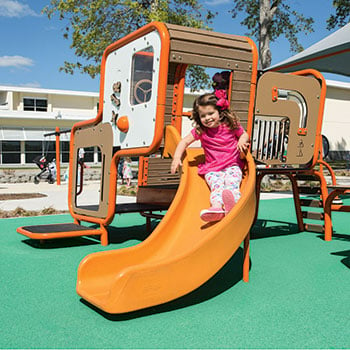 For unitary surfaces, inspections can be done on a less frequent basis, but as they age they can become less resilient. After three years, request a drop test to be sure the surface offers the necessary fall protection. Some manufactures may offer this service as part of the initial package.
For unitary surfaces, inspections can be done on a less frequent basis, but as they age they can become less resilient. After three years, request a drop test to be sure the surface offers the necessary fall protection. Some manufactures may offer this service as part of the initial package.
Browse our playground surfacing options or contact your local playground consultant to receive a surfacing quote for your playground.
Playground Surface Cost Comparison Chart
Unitary Surfacing
| Surfacing Type | Initial Investment | Lifetime Investment | Key Features & Considerations |
| Bond-in-Place Rubber | $$$ |
$ |
|
| Poured-In-Place Rubber | $$$ |
$ |
|
| Synthetic Turf |
$$$ |
$ |
|
| Resilient Tiles |
$$$ |
$ |
|
Loose Fill
| Surfacing Type | Initial Investment | Lifetime Investment | Key Features & Considerations |
| Loose Rubber | $$ |
$$$ |
|
| Sand, Pea Gravel, Wood Chip |
$ |
$$$ |
|
| Engineered Wood Fiber (EWF) or Rubber Mulch |
$ |
$$$ |
|
* Low: $, Moderate: $$, High: $$$